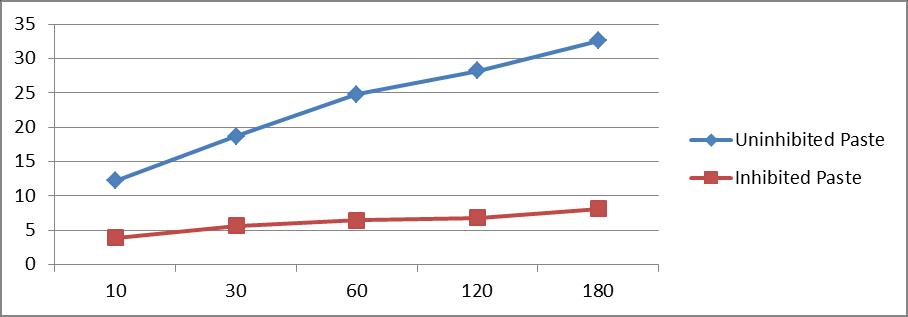
8 minute read
Temperature
from IRJET- Protection of Mild Steel from Corrosion using Seed Extract [Green Inhibitor] in Acid Envi
Volume: 08 Issue: 05 | May 2021 www.irjet.net p-ISSN: 2395-0072
Table 3 : Effect of time of application of inhibited paste on the rate of attack ofmild steel[HCl(4N);RT;3.0 gm paste/dm2 = coating thickness; castor seed = 1%]
Advertisement
Time of Application (min.)
10 30 60 120 180
Weight loss (mg/dm2) Un. In.
12.2 3.9
18.7 5.6
24.8 28.2 32.6 6.4 6.8 8.1
Inhibitor Efficiency (%IE)
68 70 74 76 75
Figure 3a : Effect of time of application of paste on the rate of attack of mild steel[HCl(4N);RT;3.0 gm paste/dm2 = coating thickness; castor seed = 1%]
X axis : Time of application (min.) Y axis : weight loss (mg/dm2)
Figure 3b : Effect of time of application of paste on the inhibitive performance of castor seed[HCl(4N);RT;3.0 gm paste/dm2 = coating thickness; castor seed = 1%]
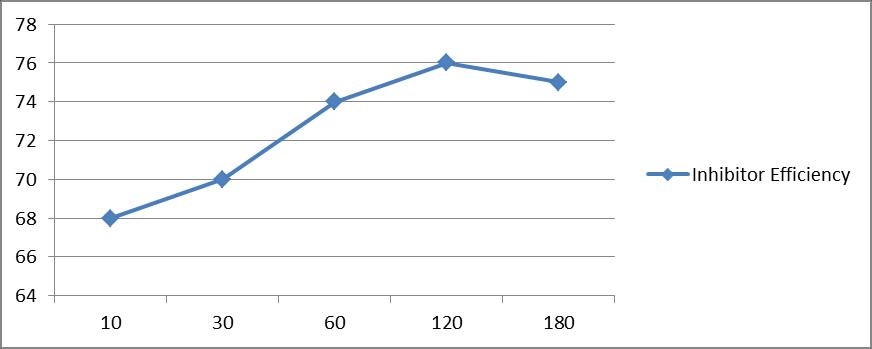
X axis : Time of application (min.) Y axis : Inhibitor Efficiency (%IE)
Volume: 08 Issue: 05 | May 2021 www.irjet.net p-ISSN: 2395-0072
D. Effect of Coating thickness :
Table 4 and figure 4[a and b] show that weight loss of mild steel specimens having paste [uninhibited] thickness 1gm/dm2 to 5 gm/dm2 varied from 15.8 mg/dm2/hr to 25.7 mg/dm2/hr ; in inhibited paste the weight loss ranged from 4.7 mg/dm2/hr to 6.7 mg/dm2/hr. Inhibitor efficiency changed from 70% to 74%.
Table 4 : Effect of coating thickness of inhibited paste on the rate of attack of mild steel[HCl(4N) ;RT; 1 hr.; castor seed = 1%]
Coating Thickness(gm/dm2)
1 2 3 4 5
Weight loss (mg/dm2)
Un. In.
15.8 20.3 24.6 26.2 25.7 4.7 5.7 6.6 6.5 6.7
Inhibitor Efficiency (%)
70 72 73 75 74
Figure 4a :Effect of time of application of paste on the rate of attack of mild steel[HCl(4N);RT;3.0 gm paste/dm2 = coating thickness; castor seed = 1%]
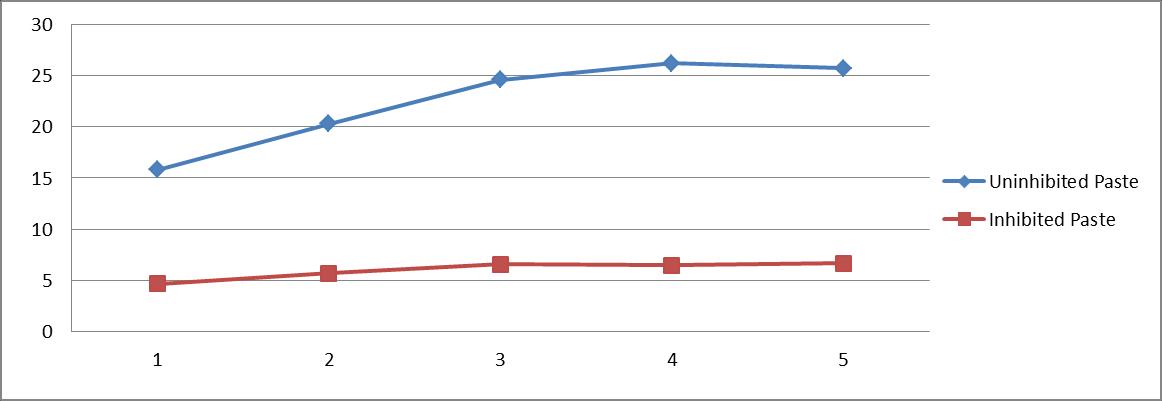
X axis :Coating Thickness(gm/dm2) Y axis : weight loss (mg/dm2)
Volume: 08 Issue: 05 | May 2021 www.irjet.net p-ISSN: 2395-0072
Figure 4b :Effect of time of application of paste on the inhibitive performance of castor seed[HCl(4N);RT;3.0 gm paste/dm2 = coating thickness; castor seed = 1%]
X axis :Coating Thickness(gm/dm2) Y axis : InhibitorEfficiency (%IE)
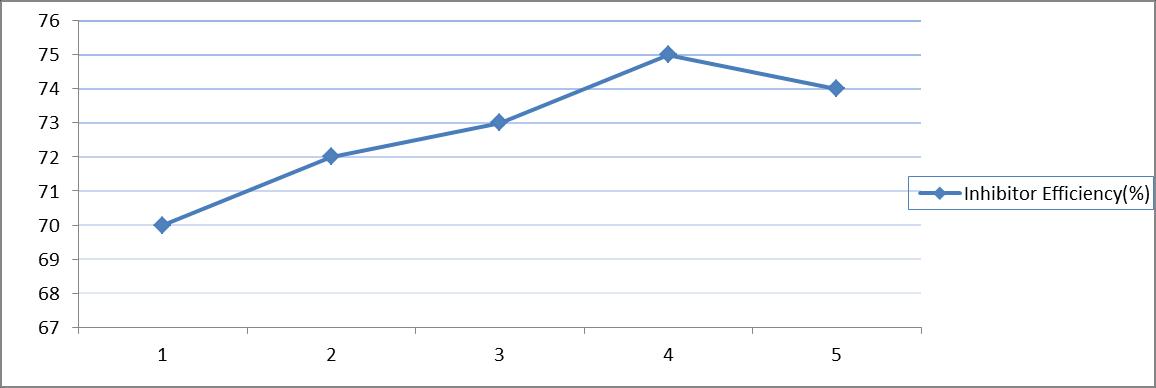
E. Effect of Water Content :
Table 5 and figure 5[a and b] show the effect of water content of paste [100% -50%] on the inhibition of corrosion of mild steel by 1.0% castor seed in the paste containing 4N HCl.In uninhibited paste the weight loss of mild steel specimens varied from 24.6 mg/dm2/hr to 26.1 mg/dm2/hr in the range of 100% water to 50% water. In inhibited system, the weight loss varied from 5.9 mg/dm2/hr to 8.6 mg/dm2/hr for the same range of water content. It is seen that the decrease in water content does not hamper the effectiveness of the inhibitor. The inhibitor efficiency varied from 76% at 100% water content to 67% at 50% water content.
Table 5 : Effect of water content of inhibited paste on the rate of attack of mildsteel[HCl(4N) ;RT;3.0 gm paste/dm2 = coating thickness; 1 hr; castor seed = 1%]
Water Content(%) Weight loss (mg/dm2)
100 90 80 70 60
Un.
24.6 25.2 27.1
30.2 28.7
In.
5.9 5.5 6.9 7.9 8.8
Inhibitor Efficiency (%)
76 78 74
73 69
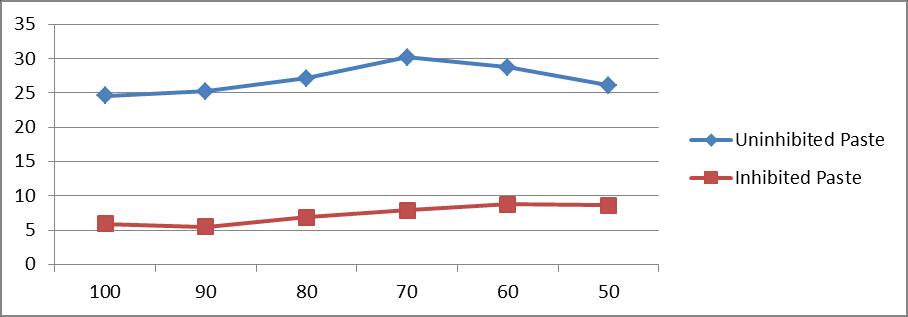
X axis :Water Content(%)
Volume: 08 Issue: 05 | May 2021 www.irjet.net p-ISSN: 2395-0072
Y axis : weight loss (mg/dm2)
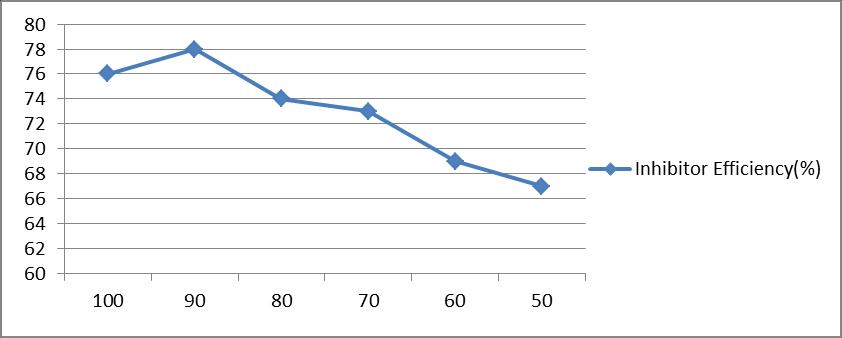
X axis :Water Content(%) Y axis : Inhibitor Efficiency (%IE)
F. Effect of temperature :
Table 6 and figure 6[a and b] show the effect of temperature (30°C-60°C) on attack of mild steel due to paste containing4N HCl with and without 1.0% Castor seed. In uninhibited paste, the weight loss of mild steel specimens varied from 19.8 mg/dm2/hr to 46.2 mg/dm2/hr in a temperature range of 30°C to 60°C. In inhibited paste, the weight loss varied from 4.8 mg/dm2/hr to 8.6 mg/dm2/hr respectively at the same temperature range. The inhibitor efficiency varied from 76% at 30°C to 81% at 60°C.
Arrhenius plots have been drawn showing the dependence of log corrosion rate on 1/T for uninhibited paste and inhibited paste. The linear nature of both the curves indicates that they obey the Arrhenius Equation.
Table 6 : Effect of Temperature on the rate of attack of mild steel [HCl(4N);1 hr.;3.0 gm paste/dm2= coating thickness; castor seed = 1%]{also shows the values of 1/T andlog weight loss to obtain Arrhenius plot}
Figure 6a : Effect of Temperature on the rate of attack of mild steel [HCl(4N);1 hr.;3.0 gm paste/dm2 = coating thickness; castor seed = 1%] [Arrhenius Plot]
Temperature (°C)
30 35 40 45 50 55 60
1/T * 104 Weight loss (mg/dm2) Un. log Weight loss In. log Weight loss Inhibitor Efficiency (%IE)
33 19.8 1.2967 4.8 0.6812 76
32.4 23.9 1.3784 6 0.7782 75
31.9 26.7 1.4265 6.1 0.7853 77
31.4 30.1 1.4786 30.9 33.8 1.5289 30.4 38.4 1.5843 30 46.2 1.6646 6.3 0.7993 79 6.8 0.8325 80 7.7 0.8865 80 8.6 0.9345 81
Volume: 08 Issue: 05 | May 2021 www.irjet.net p-ISSN: 2395-0072
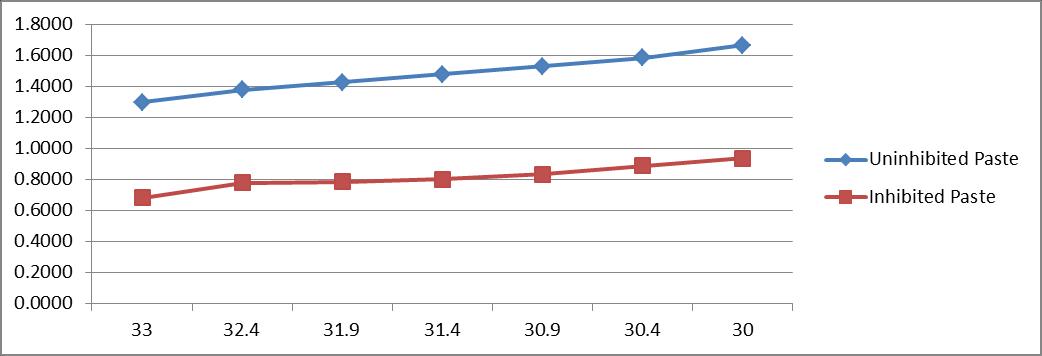
X axis : 1/T * 104 Y axis : log weight loss
Figure 6b : Effect of Temperature on inhibitive performance of castor seed [HCl(4N);1 hr.;3.0 gm paste/dm2 = coating thickness; castor seed = 1%]
X axis : Temperature (0C) Y axis : Inhibitive Efficiency (%IE)

4. CONCLUSIONS
The adsorption of castor seed extract is uniform over the surface. The extract acted mainly as anodic type inhibitor. The inhibition is due to the formation of the film on the metal/acid solution interface through adsorption of castor seed extract molecules. Chromatographic separation of the extract resulted in the isolation of
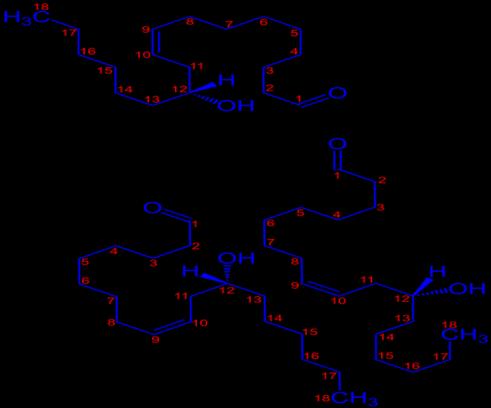
Volume: 08 Issue: 05 | May 2021 www.irjet.net p-ISSN: 2395-0072




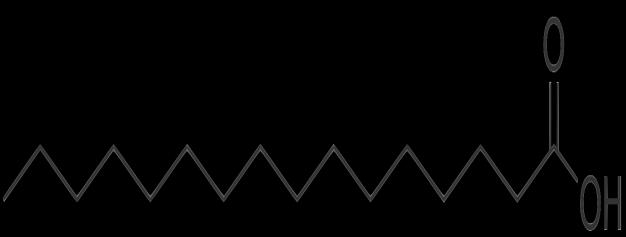

CHEMICAL CONSTITUTION OF CASTOR SEED
ACKNOWLEDGEMENT
I am grateful to DBS(PG)College for letting meuse their resources for the conduct of the experiments.
REFERENCES
1. I. N. Putilova,S. A. Balezin and V. P. Barannik,“Metallic Corrosion Inhibitor”,PergamonPress,New York,pp.104110,1960.
2. K. Srivastava and B. Sanyal,Labdev Journal of Science and Technology(India),8-A(4),pp.104,1970.
3. K. Srivastava and P.Srivastava,British Corrosion Journal,16(4),pp.221,1981.
4. H. Al-Sehaibani, “Evaluation of extracts of Henna leaves as environmentally friendly corrosion inhibitors for metals,”
Materialwissenschaft und Werkstofftechnik, vol. 31, no. 12, pp. 1060–1063, 2000.
5. M. Kliškić, J. Radošević, S. Gudić, and V. Katalinić, “Aqueous extract of Rosmarinusofficinalis L. as inhibitor of Al-Mg alloy corrosion in chloride solution,” Journal of Applied Electrochemistry, vol. 30, no. 7, pp. 823–830, 2000.
6. P. C. Okafor and E. E. Ebenso, “Inhibitive action of Carica papaya extracts on the corrosion of mild steel in acidic media and their adsorption characteristics,” Pigment and Resin Technology, vol. 36, no. 3, pp. 134–140, 2007.
7. I. H. Farooqi, A. Hussain, M. A. Quraishi, and P. A. Saini, “Study of low cost eco-friendly compounds as corrosion inhibitors for cooling systems,” Anti-Corrosion Methods and Materials, vol. 46, no. 5, pp. 328–331, 1999.
8. H. H. Rehan, “Corrosion control by water-soluble extracts from leaves of economic plants,” Materialwissenschaft und
Werkstofftechnik, vol. 34, no. 2, pp. 232–237, 2003.
Volume: 08 Issue: 05 | May 2021 www.irjet.net p-ISSN: 2395-0072
9. K. O. Orubite and N. C. Oforka, “Inhibition of the corrosion of mild steel in hydrochloric acid solutions by the extracts of leaves of NypafruticansWurmb,” Materials Letters, vol. 58, no. 11, pp. 1768–1772, 2004.
10. E. A. Noor, “Comparative study on the corrosion inhibition of mild steel by aqueous extract of Fenugreek seeds and leaves in acidic solution,” Journal of Engineering and Applied Sciences, vol. 3, no. 1, pp. 23–30, 2008.
11. J. Buchweishaija and G. S. Mhinzi, “Natural products as a source of environmentally friendly corrosion inhibitors: the case of gum exudate from Acacia seyal var. seyal,” PortugaliaeElectrochimicaActa, vol. 26, no. 3, pp. 257–265, 2008.
12. E. E. Oguzie, “Evaluation of the inhibitive effect of some plant extracts on the acid corrosion of mild steel,” Corrosion
Science, vol. 50, no. 11, pp. 2993–2998, 2008.
13. P. C. Okafor, M. E. Ikpi, I. E. Uwah, E. E. Ebenso, U. J. Ekpe, and S. A. Umoren, “Inhibitory action of Phyllanthusamarus extracts on the corrosion of mild steel in acidic media,” Corrosion Science, vol. 50, no. 8, pp. 2310–2317, 2008.
14. M. A. Quraishi, A. Singh, V. K. Singh, D. K. Yadav, and A. K. Singh, “Green approach to corrosion inhibition of mild steel in hydrochloric acid and sulphuric acid solutions by the extract of Murrayakoenigii leaves,” Materials Chemistry and
Physics, vol. 122, no. 1, pp. 114–122, 2010.
15. E. A. Noor, “Potential of aqueous extract of Hibiscus sabdariffa leaves for inhibiting the corrosion of aluminum in alkaline solutions,” Journal of Applied Electrochemistry, vol. 39, no. 9, pp. 1465–1475, 2009.
16. F. S. de Souza and A. Spinelli, “Caffeic acid as a green corrosion inhibitor for mild steel,” Corrosion Science, vol. 51, no. 3, pp. 642–649, 2009.
17. A. M. Badiea and K. N. Mohana, “Corrosion mechanism of low-carbon steel in industrial water and adsorption thermodynamics in the presence of some plant extracts,” Journal of Materials Engineering and Performance, vol. 18, no. 9, pp. 1264–1271, 2009.
18. L. R. Chauhan and G. Gunasekaran, “Corrosion inhibition of mild steel by plant extract in dilute HCl medium,” Corrosion
Science, vol. 49, no. 3, pp. 1143–1161, 2007.
BIOGRAPHIES
1’st Author Photo
Dr. Mahima Srivastava is M.Sc. [GOLD MEDALLIST], Ph.D and Associate Professor, Department of Chemistry, DBS (PG) College, Dehradun, Uttarakhand, INDIA. She has a teaching experience of more than fourteen years.





